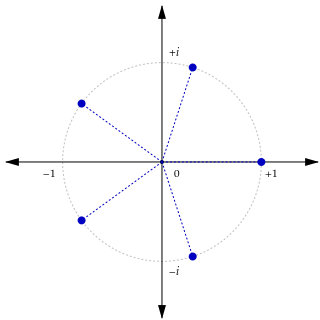Formal definition
A group is said to have the Howson property if for every finitely generated subgroups of their intersection is again a finitely generated subgroup of . [2]
In the mathematical subject of group theory, the Howson property, also known as the finitely generated intersection property (FGIP), is the property of a group saying that the intersection of any two finitely generated subgroups of this group is again finitely generated. The property is named after Albert G. Howson who in a 1954 paper established that free groups have this property. [1]
A group is said to have the Howson property if for every finitely generated subgroups of their intersection is again a finitely generated subgroup of . [2]

In mathematics, an inner product space is a real vector space or a complex vector space with an operation called an inner product. The inner product of two vectors in the space is a scalar, often denoted with angle brackets such as in . Inner products allow formal definitions of intuitive geometric notions, such as lengths, angles, and orthogonality of vectors. Inner product spaces generalize Euclidean vector spaces, in which the inner product is the dot product or scalar product of Cartesian coordinates. Inner product spaces of infinite dimension are widely used in functional analysis. Inner product spaces over the field of complex numbers are sometimes referred to as unitary spaces. The first usage of the concept of a vector space with an inner product is due to Giuseppe Peano, in 1898.
In mathematics, a profinite group is a topological group that is in a certain sense assembled from a system of finite groups.
In mathematics, a presentation is one method of specifying a group. A presentation of a group G comprises a set S of generators—so that every element of the group can be written as a product of powers of some of these generators—and a set R of relations among those generators. We then say G has presentation

In abstract algebra, a generating set of a group is a subset of the group set such that every element of the group can be expressed as a combination of finitely many elements of the subset and their inverses.

In group theory, the quaternion group Q8 (sometimes just denoted by Q) is a non-abelian group of order eight, isomorphic to the eight-element subset of the quaternions under multiplication. It is given by the group presentation
In Riemannian geometry, the sectional curvature is one of the ways to describe the curvature of Riemannian manifolds. The sectional curvature K(σp) depends on a two-dimensional linear subspace σp of the tangent space at a point p of the manifold. It can be defined geometrically as the Gaussian curvature of the surface which has the plane σp as a tangent plane at p, obtained from geodesics which start at p in the directions of σp. The sectional curvature is a real-valued function on the 2-Grassmannian bundle over the manifold.
In mathematics, specifically group theory, the free product is an operation that takes two groups G and H and constructs a new group G ∗ H. The result contains both G and H as subgroups, is generated by the elements of these subgroups, and is the “universal” group having these properties, in the sense that any two homomorphisms from G and H into a group K factor uniquely through a homomorphism from G ∗ H to K. Unless one of the groups G and H is trivial, the free product is always infinite. The construction of a free product is similar in spirit to the construction of a free group.

In mathematics, the Hawaiian earring is the topological space defined by the union of circles in the Euclidean plane with center and radius for endowed with the subspace topology:
In mathematics, subgroup growth is a branch of group theory, dealing with quantitative questions about subgroups of a given group.
In group theory, a word metric on a discrete group is a way to measure distance between any two elements of . As the name suggests, the word metric is a metric on , assigning to any two elements , of a distance that measures how efficiently their difference can be expressed as a word whose letters come from a generating set for the group. The word metric on G is very closely related to the Cayley graph of G: the word metric measures the length of the shortest path in the Cayley graph between two elements of G.

In mathematics, specifically in group theory, the direct product is an operation that takes two groups G and H and constructs a new group, usually denoted G × H. This operation is the group-theoretic analogue of the Cartesian product of sets and is one of several important notions of direct product in mathematics.
In differential geometry, the Margulis lemma is a result about discrete subgroups of isometries of a non-positively curved Riemannian manifold. Roughly, it states that within a fixed radius, usually called the Margulis constant, the structure of the orbits of such a group cannot be too complicated. More precisely, within this radius around a point all points in its orbit are in fact in the orbit of a nilpotent subgroup.

In Lie theory and related areas of mathematics, a lattice in a locally compact group is a discrete subgroup with the property that the quotient space has finite invariant measure. In the special case of subgroups of Rn, this amounts to the usual geometric notion of a lattice as a periodic subset of points, and both the algebraic structure of lattices and the geometry of the space of all lattices are relatively well understood.
In the mathematical subject of group theory, the rank of a groupG, denoted rank(G), can refer to the smallest cardinality of a generating set for G, that is
In mathematics, specifically group theory, a descendant tree is a hierarchical structure that visualizes parent-descendant relations between isomorphism classes of finite groups of prime power order , for a fixed prime number and varying integer exponents . Such groups are briefly called finitep-groups. The vertices of a descendant tree are isomorphism classes of finite p-groups.
In mathematics, the Weil–Brezin map, named after André Weil and Jonathan Brezin, is a unitary transformation that maps a Schwartz function on the real line to a smooth function on the Heisenberg manifold. The Weil–Brezin map gives a geometric interpretation of the Fourier transform, the Plancherel theorem and the Poisson summation formula. The image of Gaussian functions under the Weil–Brezin map are nil-theta functions, which are related to theta functions. The Weil–Brezin map is sometimes referred to as the Zak transform, which is widely applied in the field of physics and signal processing; however, the Weil–Brezin Map is defined via Heisenberg group geometrically, whereas there is no direct geometric or group theoretic interpretation from the Zak transform.
In the mathematical subject of group theory, a one-relator group is a group given by a group presentation with a single defining relation. One-relator groups play an important role in geometric group theory by providing many explicit examples of finitely presented groups.
In the mathematical subject of group theory, a co-Hopfian group is a group that is not isomorphic to any of its proper subgroups. The notion is dual to that of a Hopfian group, named after Heinz Hopf.
In the mathematical subject of geometric group theory, an acylindrically hyperbolic group is a group admitting a non-elementary 'acylindrical' isometric action on some geodesic hyperbolic metric space. This notion generalizes the notions of a hyperbolic group and of a relatively hyperbolic group and includes a significantly wider class of examples, such as mapping class groups and Out(Fn).
In mathematical logic, specifically in the discipline of model theory, the Fraïssé limit is a method used to construct (infinite) mathematical structures from their (finite) substructures. It is a special example of the more general concept of a direct limit in a category. The technique was developed in the 1950s by its namesake, French logician Roland Fraïssé.